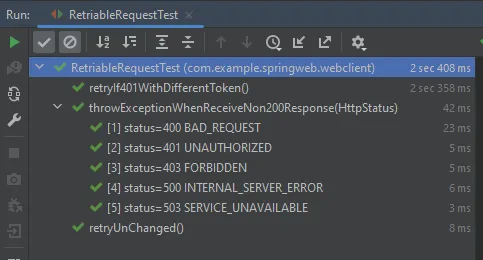Problem Statement
Sometimes web request fails, for whatever reason, and you need to retry it
Let’s simulate a failed request scenario in a unit test. In the below code, the webClient attempts to submit a GET request to /employee/100 (stored in constant PATH). We mocked the backend server to fail with common status codes such as BAD_REQUEST, UNAUTHORIZED and validate that the client throws WebClientResponseException upon receiving such statuses.
@ParameterizedTest
@EnumSource(value = HttpStatus.class, mode = EnumSource.Mode.INCLUDE, names = {
"BAD_REQUEST", "UNAUTHORIZED", "FORBIDDEN",
"SERVICE_UNAVAILABLE", "INTERNAL_SERVER_ERROR"
})
void throwExceptionWhenReceiveNon200Response(HttpStatus status) throws InterruptedException {
// request
var webClient = WebClient.builder().baseUrl(baseUrl).build();
var request = webClient.get()
.uri(PATH)
.retrieve()
.bodyToMono(String.class);
// response to first request with fail status
mockBackEnd.enqueue(new MockResponse().setResponseCode(status.value()));
// assert that exception thrown due to non-200 response
var ex = assertThrows(WebClientResponseException.class, () -> request.block());
assertEquals(status, ex.getStatusCode());
// extra assert that the path is correct
assertEquals(PATH, mockBackEnd.takeRequest().getPath());
}
Retry unchanged
The easiest task is just retrying with the same request details.
We can use retryWhen(Retry retrySpec) to configure a retry specification in the form of an RetrySpec instance. RetrySpec supports various static builder methods that we can use to quickly set one up. In the example below, we set the maximum number of retries to 1 by calling .max(1). In a similar manner, we specify a filtering condition for retry by invoking .filter(e -> e instanceof WebClientResponseException.ServiceUnavailable))
Let’s see it in action. First off, we need to mock 2 responses:
- One for the original request. It should fail.
- And one for the retry request. It should succeed to keep our test fast.
Then, as we can see from assertDoesNotThrow(() -> requestWithRetry.block()), our requestWithRetry instance does not result in any exception when invoked. And there are indeed 2 requests sent, a failed original request and a successful retried request.
@Test
void retryUnChanged() throws InterruptedException {
// request
var webClient = WebClient.builder().baseUrl(baseUrl).build();
var request = webClient.get()
.uri(PATH)
.retrieve()
.bodyToMono(String.class)
;
var requestWithRetry = request.retryWhen(RetrySpec.max(1) // retry at most once
.filter(e -> e instanceof WebClientResponseException.ServiceUnavailable));
// response to first request with a SERVICE_UNAVAILABLE
mockBackEnd.enqueue(new MockResponse().setResponseCode(HttpStatus.SERVICE_UNAVAILABLE.value()));
// response to 2nd request with 200
mockBackEnd.enqueue(new MockResponse().setBody("Successful!"));
// no more WebClientResponseException.ServiceUnavailable exception
assertDoesNotThrow(() -> requestWithRetry.block());
// assert that there are 2 requests sent
assertEquals(PATH, mockBackEnd.takeRequest().getPath());
assertEquals(PATH, mockBackEnd.takeRequest().getPath());
}
Retry with modification
It is harder to retry with modification.
Let’s consider a common scenario in OAuth-protected API invocation. After obtaining a valid OAuth token, our client can immediately make multiple API calls to the resource server. However, after some time, the token expired and our client’s API calls start to fail with HTTP 401 errors. When it first happens, we need to refresh the token and retry the request with the refreshed valid token.
Assuming we delegate the storing and refreshing of tokens to another class, it is logical to invoke the refreshToken() method before the retry.
Similar to retrying unchanged, we create an requestWithRetry instance with the help of retryWhen(Retry retrySpec) method. A difference here is the presence of .doBeforeRetry(retrySignal -> tokenSupplier.refreshToken()) expression which executes tokenSupplier.refreshToken() just before retrying.
interface TokenSupplier {
String getToken();
void refreshToken();
}
...
var requestWithRetry = request.retryWhen(RetrySpec.max(1) // retry at most once
.doBeforeRetry(retrySignal -> tokenSupplier.refreshToken())
.filter(e -> e instanceof WebClientResponseException.Unauthorized));
Done? **Not quite**. The below does not work as `webClient` probably reused the original request instance thus not submitting the refreshed token obtained when we `doBeforeRetry`
var request = webClient.get()
.uri(PATH)
.headers(headers -> headers.set(HttpHeaders.AUTHORIZATION, tokenSupplier.getToken()))
.retrieve()
.bodyToMono(String.class)
;
var requestWithRetry = request.retryWhen(RetrySpec.max(1) // retry at most once
.doBeforeRetry(retrySignal -> tokenSupplier.refreshToken())
.filter(e -> e instanceof WebClientResponseException.Unauthorized));
The solution is to re-create the request in each retry with the Mono.defer method. This ensures that each request is created fresh with the current valid token. The above should be written as below — notice the entire request-creation expression is wrapped inside Mono.defer() method call:
var request = Mono.defer(() -> webClient.get()
.uri(PATH)
.headers(headers -> headers.set(HttpHeaders.AUTHORIZATION, tokenSupplier.getToken()))
.retrieve()
.bodyToMono(String.class)
);
var requestWithRetry = request.retryWhen(RetrySpec.max(1) // retry at most once
.doBeforeRetry(retrySignal -> tokenSupplier.refreshToken())
.filter(e -> e instanceof WebClientResponseException.Unauthorized));
The entire unit test is below for your reference:

All tests passed (screenshot)
interface TokenSupplier {
String getToken();
void refreshToken();
}
@Test
void retryIf401WithDifferentToken() throws InterruptedException {
String firstToken = "FIRST TOKEN";
String secondToken = "SECOND TOKEN";
TokenSupplier tokenSupplier = spy(new TokenSupplier() {
String currentToken = firstToken;
@Override
public String getToken() {
return currentToken;
}
@Override
public void refreshToken() {
currentToken = secondToken;
}
});
// request
var webClient = WebClient.builder().baseUrl(baseUrl).build();
var request = Mono.defer(() -> webClient.get()
.uri(PATH)
.headers(headers -> headers.set(HttpHeaders.AUTHORIZATION, tokenSupplier.getToken()))
.retrieve()
.bodyToMono(String.class)
);
var requestWithRetry = request.retryWhen(RetrySpec.max(1) // retry at most once
.doBeforeRetry(retrySignal -> tokenSupplier.refreshToken())
.filter(e -> e instanceof WebClientResponseException.Unauthorized));
// response to first request with a 401
mockBackEnd.enqueue(new MockResponse().setResponseCode(HttpStatus.UNAUTHORIZED.value()));
// response to 2nd request with 200
mockBackEnd.enqueue(new MockResponse().setBody("Successful!"));
// no more WebClientResponseException.Unauthorized exception
assertDoesNotThrow(() -> requestWithRetry.block());
// assert that first request failed with a 401 with firstToken sent
RecordedRequest recordedRequest = mockBackEnd.takeRequest();
assertEquals(firstToken, recordedRequest.getHeader(HttpHeaders.AUTHORIZATION));
// assert that 2nd request passed with secondToken sent
recordedRequest = mockBackEnd.takeRequest();
assertEquals(secondToken, recordedRequest.getHeader(HttpHeaders.AUTHORIZATION));
// verify that tokenSupplier is invoked
verify(tokenSupplier, times(2)).getToken(); // twice
verify(tokenSupplier).refreshToken();
}
Sample codes
Available in my GitHub.
comments powered by Disqus